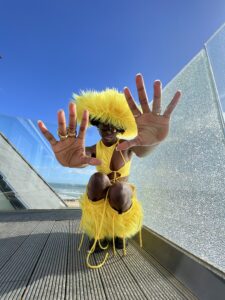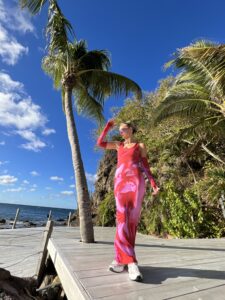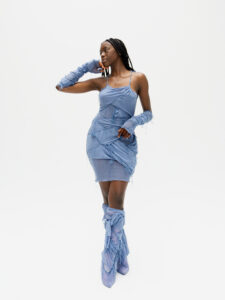Felicia Roberts
After a year’s study in Milan and an internship at Richard Quinn’s fashion house, it’s now Imogen Evans’ turn to start a successful business. Evans may only be 23 years old but she already runs a rapidly growing fashion brand, Imi Studios.
I got the chance to sit down with the independent fashion designer to talk about her creative process, dynamic designs, and future projects. Here’s what Evans had to say:
Can you talk through what your design process looks like?
So, I usually start by setting a day for when I want my next collection to be released. A couple of months before that date, I will start thinking about my ideas and pinning images on Pinterest. I might develop a few sketches or go on Photoshop to create some prints using images that I’ve taken. Most of this I don’t end up using – but it’s through this process that something just clicks. I’m all over the place with ideas at first, but as soon as I’ve thought of the first piece, and then the second piece, it begins to fit into place quite quickly.

Are there any specific decades or artists that inspire your work?
I would say that the 90s inspire me, but I wouldn’t pinpoint my inspiration to a certain decade because there are elements of so many decades that inspire my work and impress me. There are designers that I am really inspired by, such as Charlotte Knowles, Molly Goddard, and Craig Green – especially as they’re British designers who have become successful. I love watching success stories. Recently, businesswomen have inspired me so much. Because I handle the business side within my own brand, I have been looking towards female entrepreneurs for inspiration
Do you stay up to date with fashion trends?
It’s always good to be aware of what trends there are but just because I’ve recognised a trend, it doesn’t mean I’ll incorporate that trend if it doesn’t feel right for me. I mostly keep up with the trends via fashion critics, analysts on TikTok, WGSN, and even Pinterest and Instagram.
Is your personal style the same as your design aesthetic? In other words, do you design with yourself in mind?
It’s interesting because I used to wear exclusively pink. I would literally dress like a 12-year-old! Pink, Barbie, sparkles and all that. I don’t know if I was being ironic because my designs were slightly darker and deconstructed. Now, those two aesthetics have met in the middle. I do love colour and prints but it’s more elevated than my personal style used to be. I’m always wearing my own garments which is good because at least I never have to buy clothes – I just keep one of everything when I drop a collection!

On your website, you mentioned that your brand is sustainable and that you make garments to order. I think that this is applaudable – could you talk a bit more about what inspired you to take this stance?
Nowadays, we should all be taking a sustainable stance because of the direction the environment is heading. I think that’s why so many younger designers and brand owners particularly are going down a sustainable route. I do believe that sustainable fashion is a bit of an oxymoron, because the best way to be sustainable is to reuse and buy nothing new. However, while there’s still a current market, I would like to give people the choice to purchase affordable products from a brand that creates minimal waste and use sustainable packaging.
How did you get the opportunity to intern with Richard Quinn?
I cold-emailed! I had been applying to loads and loads of jobs, but I hadn’t been successful at all. I ended up making a list of 5 or 6 brands that I liked, and I e-mailed them all directly. Richard Quinn replied saying he wanted to give me an interview.
I frequently find myself not feeling good enough to go into fashion and I’m sure this is something others struggle with too. Can you talk a little bit about your strengths and weaknesses?
I used to get imposter syndrome! When I was interning at Richard Quinn, everyone was from amazing fashion schools, or had just finished a degree, whereas I didn’t know a lot. A lot of my pattern cutting and sewing were self-taught, so I would be frantically Googling stuff in the toilet after being asked to complete a task. I felt like… “oh my god, I’m the worst here”. But eventually I was able to realise that I do have strengths. For example, I’m really good at making social media content, and I’ve got good business acumen, which is useful when starting a small brand. So, I would say my biggest weakness used to be that I didn’t believe in myself, and my biggest strength is that I’m versatile.

If you could go back to the very beginning when you decided you were going to build a fashion brand, what would you do differently?
I would say that when building a brand, before committing to anything, make sure you’ve thought out every potential outcome. Make sure that whenever you’re working with somebody, you get them to sign a contract. Whether that’s a manufacturer, an influencer, or a stylist, always have a contract in place.
Finally, can you talk about what’s next for Imi Studios?
Yes! I have a new collection that will hopefully be launching in November. This will be the first collection that I’ve had manufactured. I’m working with a female lead, small batch manufacturer in Croatia – I hope that this launch is going to be a pivotal point for my brand because [while it’s being manufactured] I have the free time to focus on marketing, design, and general strategy. The reason that I’ve had to sew everything myself so far is that I didn’t have any money to put into the brand when I started. Now that I have a bit of capital behind me, I can finally start outsourcing and scaling, which is really exciting!
Featured image courtesy of Imogen Evans. Shared with permission. No changes have been made to this image.

